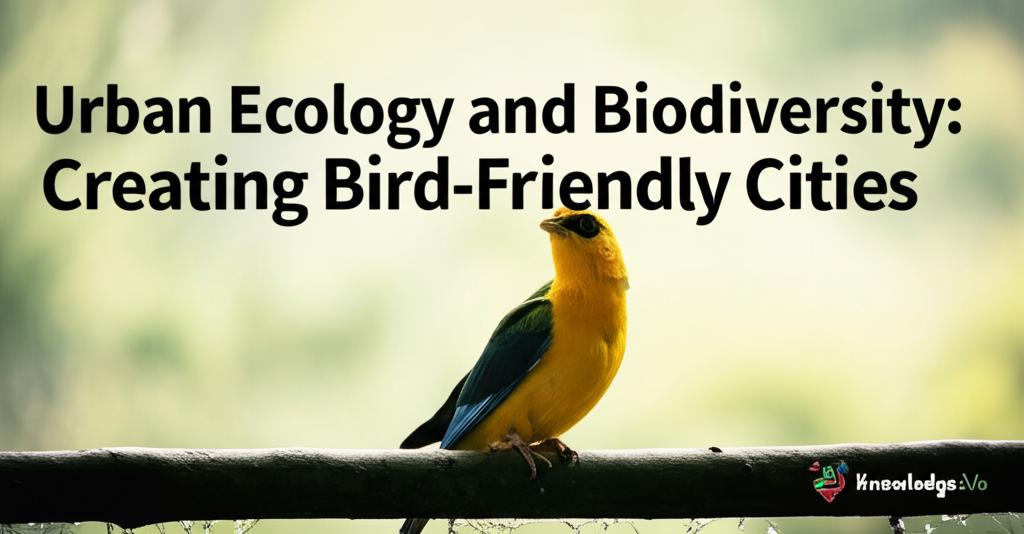Our rapidly urbanizing world presents both significant challenges and unique opportunities for avian biodiversity. As cities expand, natural habitats often shrink, yet these urban landscapes are increasingly vital for many bird species. Creating bird-friendly cities is not just an ecological imperative; it's an investment in a healthier, more resilient, and more vibrant urban future for both wildlife and people.
The Urban Challenge for BirdsUrbanization dramatically alters the environment for birds. Key challenges include:
- Habitat Loss and Fragmentation: The most significant threat is the destruction and breaking up of natural habitats like forests, wetlands, and grasslands to make way for buildings and infrastructure. This leaves birds with fewer and often lower-quality places to find food, shelter, and raise their young.
- Building Collisions: Glass-covered buildings are a major hazard. Birds perceive reflections of the sky or vegetation as open space and collide with the glass, often resulting in injury or death. Millions of birds die this way annually.
- Light Pollution: Artificial lights in cities can disorient migratory birds, particularly those that navigate by starlight or fly at night. This can lead to exhaustion, collisions, and increased vulnerability to predators.
- Noise Pollution: Urban noise can interfere with bird communication, crucial for mating, warning of predators, and other essential behaviors.
- Predation: Free-ranging domestic cats are a significant cause of bird mortality in urban and suburban areas.
- Reduced Food Sources: While some urban birds adapt to human-provided food, the overall diversity and availability of natural food sources, like native insects and seeds, can be much lower in cities, especially in areas with non-native landscaping.
- Chemical Pollutants: Pesticides and other chemicals used in urban areas can directly harm birds or reduce their insect food supply.
Fortunately, there's a growing understanding of how to design and manage cities to better support bird populations. Key strategies include:
- Integrating Green and Blue Spaces: Increasing the amount and quality of urban green spaces (parks, gardens, street trees) and blue spaces (water bodies, rivers, wetlands) is fundamental. These areas provide essential habitat. Prioritizing native vegetation is crucial, as it supports local insect populations, a primary food source for many birds. Even small, connected green patches can make a difference, acting as "stepping stones" for birds moving through the urban matrix.
- Bird-Friendly Building Design: Architects and planners can significantly reduce bird collisions by using window treatments like fritted or patterned glass, or by installing external markers or bird-safe films. Reducing unnecessary exterior lighting, especially during migration seasons, and directing lights downward can minimize disorientation for migrating birds.
- Community Engagement and Citizen Science: Educating the public about the challenges urban birds face and involving them in conservation efforts is vital. Citizen science projects, where residents help collect data on bird populations, can foster a sense of stewardship and provide valuable information for researchers and planners. Programs like "Lights Out" initiatives raise awareness about light pollution.
- Sustainable Urban Planning: Incorporating biodiversity needs into the earliest stages of urban planning is essential. This includes creating wildlife corridors to connect fragmented habitats, protecting existing natural areas within and around cities, and establishing buffer zones between urban development and sensitive ecosystems.
- Managing Urban Ecosystems: Thoughtful landscaping that emphasizes structural diversity (different layers of vegetation) and native plant species can create richer habitats. Retaining dead and decaying trees, where safe to do so, provides nesting cavities and food sources for insectivorous birds.
- Reducing Other Threats: Promoting responsible pet ownership, including keeping cats indoors or in secure outdoor enclosures ("catios"), can save countless bird lives. Reducing pesticide use in public and private spaces helps protect birds and their food sources.
The effort to create bird-friendly cities yields numerous benefits:
- Enhanced Biodiversity: Supporting bird populations contributes to overall urban biodiversity, creating more resilient and healthy ecosystems.
- Ecosystem Services: Birds play important roles in pollination, seed dispersal, and pest control, all of which benefit the urban environment.
- Human Well-being: The presence of birds and access to nature in cities are linked to improved mental and physical health for residents. Birdsong and the sight of birds can reduce stress and increase feelings of connection to the natural world.
- Educational Opportunities: Urban wildlife provides accessible opportunities for people, especially children, to learn about and connect with nature.
- Indicators of Environmental Health: Bird populations can serve as indicators of the overall health of the urban environment. Thriving bird communities often signal cleaner air and water and more robust green spaces.
As our world becomes increasingly urban, recognizing the importance of urban ecology and actively working to create cities where both people and birds can flourish is more critical than ever. Through thoughtful planning, innovative design, and community action, we can build urban environments that are truly shared spaces.

